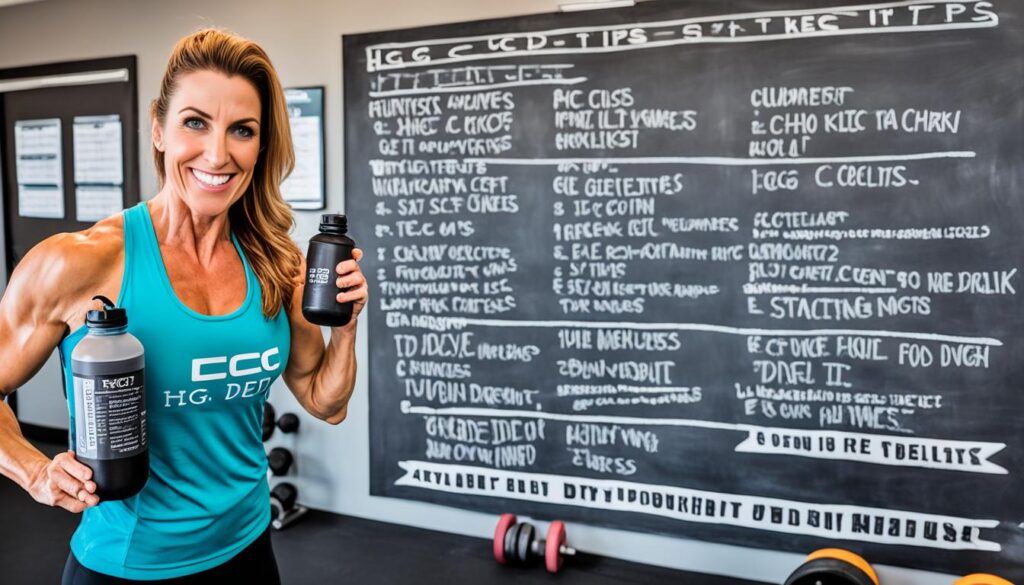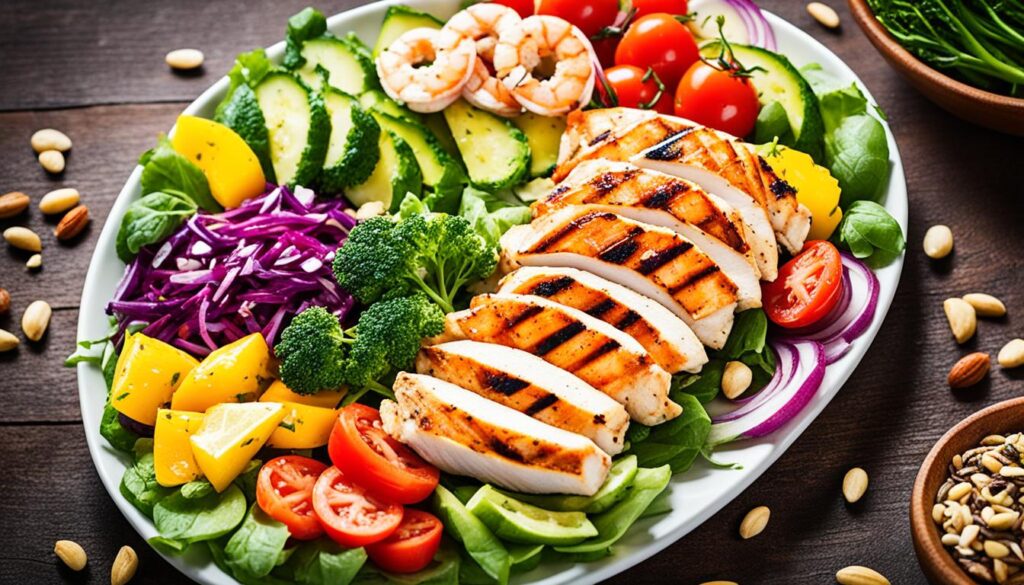Did you know that incorporating exercise during the HCG diet can greatly enhance weight loss results? While it may seem counterintuitive, maintaining a regular exercise routine while following the HCG diet can help individuals not only shed pounds but also maintain muscle tone and overall fitness.
When it comes to weight loss, the HCG diet is known for its effectiveness. By combining daily injections or drops of human chorionic gonadotropin (HCG) with a low-calorie diet, individuals can experience rapid weight loss.
However, it is important to approach exercise with caution while on the HCG diet. Although intense workouts may hinder weight loss due to the limited calorie intake, gentle activities like walking, yoga, or biking can be safely incorporated to maintain muscle mass and cardiovascular fitness.
In this article, I will provide you with valuable tips on how to navigate the HCG diet and exercise regimen for optimal weight loss and overall well-being. From understanding the impact of HCG on weight loss to recommended exercises during the different phases of the diet, you’ll gain insights and strategies to achieve long-term success.
Key Takeaways:
- Regular exercise can enhance weight loss results while on the HCG diet.
- Gentle activities like walking, yoga, or biking are recommended to maintain muscle tone.
- High-intensity workouts may hinder weight loss due to limited calorie intake.
- Exercise during the maintenance phase can support long-term weight maintenance.
- Adopting a balanced nutrition plan and making sustainable lifestyle changes are key to long-term success.
The Impact of HCG on Weight Loss
The HCG diet is a weight loss method that combines daily injections of human chorionic gonadotropin (HCG) with a low-calorie diet. This unique approach aims to maximize weight loss by utilizing stored fat for energy when calorie consumption is limited. In other words, HCG helps the body burn fat more efficiently, resulting in rapid weight loss.
During the HCG diet, individuals adhere to a low-calorie diet while receiving HCG injections or using HCG drops. The combination of calorie restriction and HCG supplementation enhances fat burning and enables the body to shed excess weight.
However, it is important to note that vigorous exercise while on the HCG diet may have an impact on weight loss. Due to the limited calorie intake, intense workouts can lead to dizziness or exhaustion. Therefore, it is recommended to follow the recommended exercise guidelines and opt for light exercises that help maintain muscle tone without compromising weight loss progress. Walking, yoga, and easy biking are great low-impact activities to incorporate into your routine while on the HCG diet.
The Role of Calorie Consumption and Fat Burn
One of the key mechanisms of the HCG diet is the significant reduction in calorie consumption. By adhering to a low-calorie diet plan while receiving HCG injections or drops, the body is forced to tap into its fat stores for energy. This stimulates fat burning and helps individuals experience considerable weight loss within a short period of time.
As the body enters a state of caloric deficit, it turns to stored fat as its primary energy source. The presence of HCG helps minimize the loss of muscle mass and ensures that the body targets fat stores for fuel instead. This is why the HCG diet is considered a highly effective weight loss method.
The Effect of HCG on Water Retention
In addition to promoting fat burn, HCG may also have an impact on water retention. Many individuals experience temporary water weight fluctuations during their weight loss journey, which can sometimes hinder progress or cause frustration.
While the exact mechanism is still not fully understood, HCG is believed to have diuretic properties, meaning it helps the body eliminate excess water and reduce water retention. This can lead to a noticeable reduction in bloating and a more defined appearance.
It is worth noting that the impact of HCG on water retention can vary between individuals, and the overall weight loss results are influenced by various factors, including diet adherence and exercise levels.
Exercise Recommendations on the HCG Diet

When following the HCG diet, incorporating regular exercise into your routine is essential for maintaining overall fitness and muscle tone. However, it’s important to choose the right types of exercises that align with the requirements and limitations of the HCG diet plan.
Light exercises are generally recommended while on the HCG diet to ensure that weight loss is not hindered. Some acceptable exercises include:
- Walking: Taking daily walks is an excellent way to stay active without putting excessive strain on your body. Start with a brisk 15-minute walk and gradually increase the duration and intensity as you progress through the diet.
- Yoga: Engaging in gentle yoga can help improve flexibility, balance, and relaxation. Look for HCG-friendly yoga routines that focus on stretching and low-impact movements.
- Easy Biking: Cycling on a stationary bike or riding a regular bike at a moderate pace is another suitable exercise option for those on the HCG diet. It provides a low-impact cardiovascular workout while engaging the leg muscles.
However, it is crucial to avoid weight lifting or any form of heavy exercise, especially for individuals who are new to exercising. The HCG diet involves a restricted calorie intake, and intense workouts can cause excessive fatigue and potential muscle loss.
As you progress through the HCG diet plan and achieve significant weight loss, you can gradually increase the intensity of your exercises. Listen to your body and make adjustments accordingly, ensuring that you don’t overwhelm yourself with heavy exercise during the diet.
Remember, the primary focus of the HCG diet is weight loss, and exercise should complement your goals rather than impede them. By following the recommended exercise recommendations and gradually increasing intensity as you achieve milestones, you can maintain a healthy exercise routine on the HCG diet while still achieving your desired weight loss outcomes.
The Benefits of Light Exercise on the HCG Diet
Engaging in light exercise while on the HCG diet offers several benefits that support your weight loss journey. These include:
- Maintaining Muscle Tone: Light exercises help preserve muscle tone and prevent muscle loss during the diet. This ensures that your body remains firm and toned as you shed excess weight.
- Improved Mood and Energy: Exercise releases endorphins, which boost mood and energy levels. Incorporating light exercises can help combat fatigue and enhance overall well-being while on the HCG diet.
- Increased Metabolism: Regular exercise, even at a light intensity, can boost your metabolism, promoting efficient calorie burning and aiding in weight loss.
- Enhanced Cardiovascular Health: Activities like walking and biking improve cardiovascular fitness, strengthening your heart and improving overall health.
By embracing light exercises that align with the HCG diet plan, you can experience the benefits of physical activity while maximizing the effectiveness of the diet.
The Phases of the HCG Diet
The HCG diet follows a structured framework consisting of several distinct phases. Each phase serves a specific purpose in achieving optimal weight loss results and long-term lifestyle changes. Let’s explore each phase of the HCG diet in detail:
Gorging/Loading Phase
The gorging/loading phase is the initial stage of the HCG diet. Lasting for two days, this phase involves consuming as much fatty and oily foods as possible while beginning HCG injections. The purpose of this phase is to prepare the body for the subsequent restricted calorie intake. By ensuring an ample supply of stored fats, the body is primed for efficient fat burning during the next phase.
Fat Burn Phase
The fat burn phase is the core of the HCG diet and lasts for 21 days. During this phase, individuals consume only 500 calories per day while continuing the HCG injections. The combination of a low-calorie diet and the effects of HCG allows the body to tap into stored fat reserves for energy. This phase promotes rapid and sustainable weight loss, primarily targeting stubborn fat deposits.
Maintenance Phase
After completing the fat burn phase, individuals enter the maintenance phase, which lasts for three weeks. During this phase, a wider variety of foods can be reintroduced into the diet. However, careful monitoring of weight is still necessary to ensure weight stability. The maintenance phase serves as a bridge between the intense fat burn phase and long-term lifestyle changes. It allows individuals to gradually adjust their eating habits and make sustainable choices for continued success.
Long-Term Lifestyle Changes
The final phase of the HCG diet involves maintaining the weight loss achieved and implementing long-term lifestyle changes. This phase focuses on sustaining healthy habits and making informed choices regarding nutrition and exercise. By adopting a balanced approach to eating and integrating regular physical activity into daily routines, individuals can ensure they maintain their desired weight in the long run.
| Phase | Description |
|---|---|
| Gorging/Loading Phase | Consuming fatty and oily foods while starting HCG injections to prepare the body for restricted calorie intake. |
| Fat Burn Phase | Following a low-calorie diet of only 500 calories per day while continuing HCG injections to promote rapid weight loss and fat burning. |
| Maintenance Phase | Reintroducing a wider range of foods while closely monitoring weight to ensure stability and gradually transition to long-term lifestyle changes. |
| Long-Term Lifestyle Changes | Implementing sustainable habits, including balanced nutrition and regular exercise, to maintain weight loss results and overall well-being. |
Recommended Foods on the HCG Diet

When following the HCG diet, the choice of foods is crucial for successful weight loss. During the fat burn phase, it is important to focus on the right balance of protein, fruits, vegetables, starches, and seasonings to ensure optimal nutrition and support the body’s fat burning process.
Protein Sources
Protein is an essential component of the HCG diet as it helps maintain muscle mass while promoting fat burn. The following lean meats can be included as protein sources:
- Beef
- Chicken breast
- White fish
- Shrimp
- Lobster
- Crab
Fruits and Vegetables
Fruits and vegetables provide essential vitamins, minerals, and fiber while being low in calories. Here are some options to include in limited quantities:
- Apples
- Oranges
- Strawberries
- Spinach
- Cucumbers
- Tomatoes
Starches
Starches are allowed in small portions on the HCG diet. These options provide a sense of satiety and can include:
- Melba toast
- Crackers
Seasonings
While following the HCG diet, it is important to avoid oils, sugary condiments, and additional fats or dressings. Instead, use natural seasonings to enhance the flavor of your meals. Some recommended seasonings include:
- Lemon juice
- Salt
- Pepper
- Herbs
By making wise food choices and following the recommended guidelines, individuals can support their weight loss journey while ensuring their nutritional needs are met. Remember to consult a healthcare professional before starting any new diet or exercise regimen.
Plateau Breakers on the HCG Diet
Experiencing a weight loss plateau during the HCG diet is common and can be frustrating. However, there are several strategies you can implement to break through this plateau and continue making progress towards your weight loss goals.
Increasing Water Intake
One effective method to overcome a weight loss plateau is by increasing your water intake. Aim to drink 6-8 glasses of water per day. Staying hydrated not only helps to flush out toxins but also aids in digestion and can boost your metabolism. By increasing your water intake, you can revitalize your weight loss journey and push through the plateau.
Adjusting Protein Intake
Another way to break through a plateau is by adjusting your protein intake. Adding an extra half ounce of protein to your daily meals can provide your body with the fuel it needs to continue burning fat. Lean protein sources like chicken breast, fish, and tofu are excellent options to consider.
Having an “Apple Day”
One unique strategy to overcome a weight loss plateau on the HCG diet is by implementing an “apple day.” During an apple day, you consume only apples and water for the entire day. This method helps to reset your body and kickstart your metabolism. Remember to choose organic apples and limit your intake to a reasonable quantity.
Avoiding Breadsticks
While following the HCG diet, it is crucial to avoid breadsticks, as they can hinder your progress. Breadsticks are typically high in carbohydrates and may impede the fat-burning process. Instead, focus on consuming the approved foods recommended for the diet and make healthier choices.
Light Exercise Routine
Adding a light exercise routine to your daily regimen can also aid in breaking through a plateau. Engaging in exercises like brisk walks or gentle yoga sessions a few times a week can boost your metabolism and help you shed those stubborn pounds. Remember to listen to your body and choose exercises that are suitable for your fitness level.
Overcoming weight loss plateaus on the HCG diet requires perseverance and commitment. By implementing these plateau breakers, such as increasing water intake, adjusting protein intake, having an “apple day,” avoiding breadsticks, and incorporating a light exercise routine, you can push past plateaus and continue towards your weight loss goals.
Transitioning to the Maintenance Phase

After completing the HCG diet, you will enter the maintenance phase, which lasts for three weeks. This phase is crucial for consolidating the weight loss you have achieved and transitioning to a sustainable long-term lifestyle. During the maintenance phase, you can begin to reintroduce a wider variety of foods into your diet while still being mindful of your carbohydrate intake. It is important to monitor your weight daily to ensure you are maintaining your progress.
When reintroducing foods, it is essential to exclude high-sugar and high-starch items that may lead to weight regain. Focusing on a balanced calorie intake that aligns with your lifestyle is key. Additionally, incorporating regular exercise into your routine during the maintenance phase can help support weight maintenance and overall well-being.
| Transitioning to the Maintenance Phase | Guidelines |
|---|---|
| Reintroducing Foods | Begin incorporating a wider variety of foods into your diet, excluding high-sugar and high-starch items. |
| Daily Weight Monitoring | Weigh yourself every morning to track any changes in your weight and make necessary adjustments. |
| Carbohydrate Restriction | Limited your carbohydrate intake, particularly sugars, to prevent weight regain. |
| Following a Balanced Calorie Intake | Ensure your daily caloric intake aligns with your lifestyle and supports weight maintenance. |
| Incorporating Exercise | Engage in regular exercise to support long-term weight maintenance and overall well-being. |
Transitioning to the maintenance phase not only allows you to enjoy a wider variety of foods but also empowers you to maintain your weight loss achievements. It is important to remember that this phase is a lifestyle transition, and adopting a balanced approach to nutrition and exercise is essential for long-term success.
The Importance of Exercise in the Maintenance Phase

The maintenance phase of the HCG diet is a crucial period for long-term weight maintenance and overall well-being. During this phase, individuals have the opportunity to reintroduce exercise into their routine, which can have numerous benefits.
Engaging in regular physical activity during the maintenance phase, such as brisk walks, yoga, or other forms of exercise, can help increase metabolism and maintain muscle tone. Regular exercise not only aids in maintaining weight loss but also supports overall cardiovascular health and improves overall fitness levels.
Exercise plays a vital role in increasing metabolism, which can contribute to sustained weight management over time.
While exercise is not required for weight loss during the HCG diet, it is highly recommended for its positive impact on overall health. Incorporating exercise into the maintenance phase can help individuals transition into a long-term healthy lifestyle, promoting weight maintenance and preventing weight regain.
Adding exercise to the maintenance phase does not have to be overwhelming. Starting with low-intensity activities like brisk walks or beginner-level yoga classes is a great way to reintroduce exercise gradually. These activities can be enjoyable, sustainable, and help individuals maintain their weight loss results.
It’s important to listen to the body and avoid pushing too hard, particularly after an extended period without exercise. Overexertion can lead to injuries or setbacks during the maintenance phase. Consulting with a healthcare professional or certified fitness instructor can provide guidance on a safe and effective exercise routine tailored to individual needs.
Regular physical activity during the maintenance phase not only supports weight maintenance but also contributes to overall well-being. Exercise has been shown to improve mood, reduce stress levels, and promote quality sleep.
In conclusion, incorporating exercise into the maintenance phase of the HCG diet is a key element for increasing metabolism, maintaining muscle tone, and supporting long-term weight maintenance. By prioritizing regular physical activity, individuals can enhance their overall health and wellness while preserving the results achieved during the HCG diet.
| Benefits of Exercise during the Maintenance Phase: |
|---|
| Increased metabolism |
| Maintained muscle tone |
| Enhanced cardiovascular health |
| Improved overall fitness |
| Promoted weight maintenance |
| Prevented weight regain |
| Boosted mood and reduced stress |
| Improved sleep quality |
Tips for Long-Term Success with HCG Diet and Exercise

To achieve long-term success with the HCG diet and exercise, it is important to incorporate healthy habits and make sustainable lifestyle changes. By following these tips, you can maintain your weight loss results and improve your overall well-being.
1. Adopt a Balanced Nutrition Plan
Focus on consuming whole foods that provide essential nutrients for your body. Include a variety of fruits, vegetables, lean proteins, and whole grains in your diet. Practice portion control to ensure you’re fueling your body with the right amount of nutrients without overeating.
2. Engage in Regular Exercise
Make regular exercise a part of your routine to maintain overall fitness and support your weight loss efforts. Incorporate activities that you enjoy such as walking, jogging, yoga, or cycling. Aim for at least 30 minutes of moderate-intensity exercise most days of the week.
3. Build a Support System
Surround yourself with people who support your goals and encourage you to stay on track. Share your progress with family, friends, or join online communities where you can find like-minded individuals who are going through similar journeys.
4. Set Realistic Goals
Define achievable and realistic goals for yourself. Breaking down your weight loss goals into smaller milestones will make them more manageable and keep you motivated along the way.
5. Stay Consistent with Healthy Habits
Consistency is key in maintaining long-term success. Stick to your balanced nutrition plan, exercise regularly, and adopt healthy habits beyond the HCG diet. Incorporate mindfulness techniques, such as meditation or journaling, to help stay focused and motivated throughout your weight loss journey.
“Success is not the key to happiness. Happiness is the key to success. If you love what you are doing, you will be successful.” – Albert Schweitzer
By implementing these tips, you can ensure that your HCG diet and exercise regimen becomes a sustainable lifestyle. Remember that long-term success is not just about achieving a certain weight; it’s about embracing healthy habits and making positive changes that enhance your overall well-being.
| Benefits of Healthy Habits and Lifestyle Changes | |
|---|---|
| Improved physical health | Enhanced mental well-being |
| Reduced risk of chronic diseases | Increased energy levels |
| Weight maintenance | Improved sleep quality |
| Boosted self-confidence | Enhanced overall quality of life |
Remember, long-term success requires dedication and commitment to maintaining a healthy lifestyle. Strive for balance, prioritize self-care, and celebrate your achievements along the way.
Image alt tag: Keywords – long-term success, healthy habits, lifestyle changes, balanced nutrition, regular exercise
Conclusion
Incorporating exercise into the HCG Diet and Exercise Regimen is key to achieving weight loss while maintaining muscle tone and overall fitness. It is essential to strike a balance between physical activity and the calorie restrictions of the diet to ensure long-term success.
Taking breaks from exercise and gradually increasing intensity as the diet progresses is crucial for avoiding burnout and potential setbacks. By listening to your body and adjusting the exercise routine accordingly, you can sustain your motivation and achieve optimal results.
Transitioning to the maintenance phase involves reintroducing a wider variety of foods while still monitoring your weight. Regular exercise during this phase is essential for supporting long-term weight maintenance and promoting overall well-being.
To achieve the best results, it is important to adopt healthy habits and make sustainable lifestyle changes. This includes maintaining a balanced nutrition plan, focusing on whole foods and portion control, and incorporating regular exercise into your routine. By committing to these changes, you can experience not only significant weight loss but also improved health and fitness for the long term.
FAQ
Can I exercise while following the HCG Diet?
Yes, it is recommended to maintain a regular exercise routine while on the HCG Diet. However, the intensity may need to be decreased during phase 2 of the diet. It is important to avoid prolonged, intense workouts that can result in dizziness or exhaustion. Gentle activities like yoga, walking, or biking are recommended to maintain exercise rhythm.
What is the HCG Diet?
The HCG diet involves daily injections or drops of human chorionic gonadotropin (HCG) along with a low-calorie diet. The HCG helps ensure that the body utilizes stored fat for energy when calorie consumption is limited, resulting in rapid weight loss.
What types of exercises are suitable on the HCG Diet?
Light exercises such as walking, yoga, and easy biking are generally recommended. These activities help maintain muscle tone without hindering weight loss. It is important to avoid weight lifting or any form of heavy exercise, especially for beginners.
What are the different phases of the HCG Diet?
The HCG diet consists of several phases. The first phase is the gorging or loading phase, followed by the fat burn phase, the maintenance phase, and finally, the long-term lifestyle changes phase.
What foods are allowed on the HCG Diet?
Protein sources like lean meats, shrimp, lobster, and crab, along with fruits and vegetables like apples, oranges, strawberries, spinach, cucumbers, and tomatoes are permitted in limited quantities. Starches like melba toast or crackers are also allowed, while oils, sugary condiments, and additional fats or dressings should be avoided.
How can I break through a weight loss plateau during the HCG Diet?
Increasing water intake, adjusting protein intake, having an “apple day,” cutting down on or eliminating beef, and checking for hidden sugars in condiments can help break through a plateau. Adding a light exercise routine or brisk walk a few times a week can also boost metabolism.
What happens during the maintenance phase of the HCG Diet?
During the maintenance phase, individuals can reintroduce a wider variety of foods into their diet while still monitoring their weight daily. Carbohydrates, particularly sugars, should be limited during this phase to prevent weight regain.
Is exercise important during the maintenance phase of the HCG Diet?
Yes, exercise is encouraged during the maintenance phase. Engaging in regular physical activity, such as brisk walks, yoga, or other forms of exercise, can help increase metabolism, maintain muscle tone, and support long-term weight maintenance.
What are some tips for long-term success with the HCG Diet and exercise?
To achieve long-term success, it is important to incorporate healthy habits and make sustainable lifestyle changes. This includes adopting a balanced nutrition plan, focusing on whole foods and portion control, as well as regular exercise to maintain overall fitness. Building a support system, setting realistic goals, and staying consistent with healthy habits are also key factors in maintaining weight loss and achieving optimal health and fitness results.
What is the overall importance of the HCG Diet and exercise regimen tips?
The HCG Diet and exercise regimen tips provide guidance on incorporating exercise, following the diet phases, making healthy food choices, breaking through plateaus, transitioning to the maintenance phase, and achieving long-term success. They promote weight loss, healthy lifestyle habits, and sustainable results.

